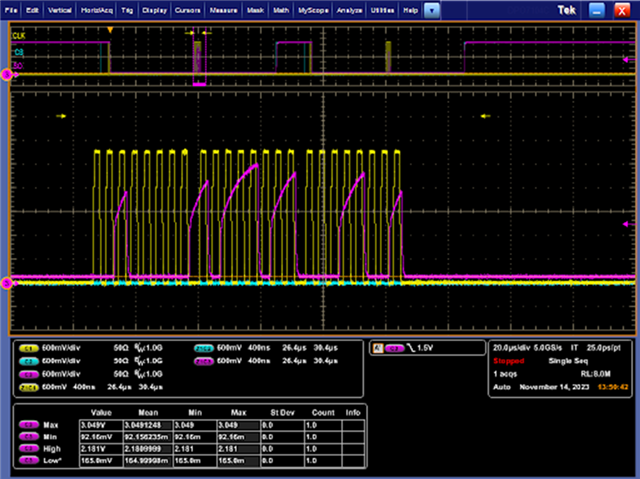Other Parts Discussed in Thread: TXU0304
Hi Team,
My customer use LSF0108 for SPI level transition. Customer report that the voltage on B side is 1.8V which is equal to VCCA. Could you pls review the schematic and advise? Thanks!

Regards,
Hailiang
This thread has been locked.
If you have a related question, please click the "Ask a related question" button in the top right corner. The newly created question will be automatically linked to this question.
Hi Ladisch,
When this device is used in SPI applications, does it still need a pull-up? R5275 does not have 2 placed, so I guess the EN Pin connection is correct.
Regards,
Hailiang
Hi Ladisch,
B2 was pulled up to 3.3V through a 2.2k resistor, but the voltage of this pin was abnormal. The waveform is as follows(Red). Is there any other suggestions? Thanks.

Regards,
Hailiang
The line capacitance and the pull-up resistor form an R-C low-pass filter. To get faster edges, you need stronger (smaller) pull-up resistors.
The LSF's architecture is necessary for bidirectional translation. For unidirectional signals like SPI, a unidirectional translator like the TXU0304 would be a better choice.
Hi Ladisch,
When reducing the pull-up resistor of MISO to 330ohm, the waveform is improved, see the purple waveform in the figure below, but at this time the low voltage level reaches 600mV. Considering that the current through the pass transistor is only 9mA, this low level seems too high. Do you have any comments?
As can be seen from the picture, the rising edge of purple MISO is still slow when the pull-up resistor is 330ohm, but the clock signal CLK is not connected to an external pull-up resistor, but its waveform is good. Why is this?

Regards,
Hailiang
The LSF is a passive switch. The low level depends on the drive strength of the other devices.
For voltages below VREF_A, the LSF works as an analog switch. So slow edges happen only when translating to a higher voltage.
The TXU0304 would not have these problems.
Hi Ladisch,
Any comments on the questions 2:
As can be seen from the picture, the rising edge of purple MISO is still slow when the pull-up resistor is 330ohm, but the clock signal CLK is not connected to an external pull-up resistor, but its waveform is good. Why is this?
Regards,
Hailiang
Because the clock and MISO signals go in opposite direction. The master actively drives the clock up to 3.3 V, so the output quickly reaches 1.8 V. But the slave drives the MISO signal only up to 1.8 V, so the remaining rising edge is driven weakly, only by the pull-up resistor.
The TXU0304 would not have these problems.